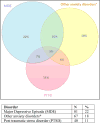Prevalence and predictors of anxiety disorders amongst low-income pregnant women in urban South Africa: a cross-sectional study
- PMID: 28852868
- PMCID: PMC6086488
- DOI: 10.1007/s00737-017-0768-z
Prevalence and predictors of anxiety disorders amongst low-income pregnant women in urban South Africa: a cross-sectional study
Abstract
Anxiety is highly prevalent in many populations; however, the burden of anxiety disorders amongst pregnant women in low-resource settings is not well documented. We investigated the prevalence and predictors of antenatal anxiety disorders amongst low-income women living with psychosocial adversity. Pregnant women were recruited from an urban, primary level clinic in Cape Town, South Africa. The Mini-International Neuropsychiatric Interview diagnostic interview assessed prevalence of anxiety disorders. Four self-report questionnaires measured psychosocial characteristics. Logistic regression models explored demographic and socioeconomic characteristics, psychosocial risk factors and psychiatric comorbidity as predictors for anxiety disorders. Amongst 376 participants, the prevalence of any anxiety disorder was 23%. Although 11% of all women had post-traumatic stress disorder, 18% of the total sample was diagnosed with other anxiety disorders. Multivariable analysis revealed several predictors for anxiety including a history of mental health problems (adjusted odds ratio [AOR] 4.11; 95% confidence interval (CI) 2.03-8.32), Major depressive episode (MDE) diagnosis (AOR 3.83; CI 1.99-7.31), multigravidity (AOR 2.87; CI 1.17-7.07), food insecurity (AOR 2.57; CI 1.48-4.46), unplanned and unwanted pregnancy (AOR 2.14; CI 1.11-4.15), pregnancy loss (AOR 2.10; CI 1.19-3.75) and experience of threatening life events (AOR 1.30; CI 1.04-1.57). Increased perceived social support appeared to reduce the risk for antenatal anxiety (AOR 0.95; CI 0.91-0.99). A range of antenatal anxiety disorders are prevalent amongst pregnant women living in low-resource settings. Women who experience psychosocial adversity may be exposed to multiple risk factors, which render them vulnerable to developing antenatal anxiety disorders.
Keywords: Antenatal anxiety disorders; Low-income setting; Perinatal mental health; Pregnancy; Risk factors.
Figures
Similar articles
-
Antenatal depression and adversity in urban South Africa.J Affect Disord. 2016 Oct;203:121-129. doi: 10.1016/j.jad.2016.05.052. Epub 2016 Jun 2. J Affect Disord. 2016. PMID: 27285725 Free PMC article.
-
Domestic and intimate partner violence among pregnant women in a low resource setting in South Africa: a facility-based, mixed methods study.BMC Womens Health. 2018 Jul 4;18(1):119. doi: 10.1186/s12905-018-0612-2. BMC Womens Health. 2018. PMID: 29973182 Free PMC article.
-
Factors associated with household food insecurity and depression in pregnant South African women from a low socio-economic setting: a cross-sectional study.Soc Psychiatry Psychiatr Epidemiol. 2018 Apr;53(4):363-372. doi: 10.1007/s00127-018-1497-y. Epub 2018 Feb 14. Soc Psychiatry Psychiatr Epidemiol. 2018. PMID: 29445850 Free PMC article.
-
Social determinants of antenatal depression and anxiety among women in South Asia: A systematic review & meta-analysis.PLoS One. 2022 Feb 9;17(2):e0263760. doi: 10.1371/journal.pone.0263760. eCollection 2022. PLoS One. 2022. PMID: 35139136 Free PMC article.
-
Anxiety and Related Disorders During the Perinatal Period.Annu Rev Clin Psychol. 2025 May;21(1):465-496. doi: 10.1146/annurev-clinpsy-081423-020126. Epub 2025 Feb 14. Annu Rev Clin Psychol. 2025. PMID: 39952634 Review.
Cited by
-
Developing a task-sharing psychological intervention to treat mild to moderate symptoms of perinatal depression and anxiety in South Africa: a mixed-method formative study.Int J Ment Health Syst. 2021 Mar 15;15(1):23. doi: 10.1186/s13033-021-00443-5. Int J Ment Health Syst. 2021. PMID: 33722252 Free PMC article.
-
Tools for screening maternal mental health conditions in primary care settings in sub-Saharan Africa: systematic review.Front Public Health. 2024 Sep 26;12:1321689. doi: 10.3389/fpubh.2024.1321689. eCollection 2024. Front Public Health. 2024. PMID: 39391163 Free PMC article.
-
The delay of motherhood: Reasons, determinants, time used to achieve pregnancy, and maternal anxiety level.PLoS One. 2019 Dec 30;14(12):e0227063. doi: 10.1371/journal.pone.0227063. eCollection 2019. PLoS One. 2019. PMID: 31887126 Free PMC article.
-
Prevalence of Prenatal Depression Among Pregnant Women and the Importance of Resilience: A Multi-Site Questionnaire-Based Survey in Mainland China.Front Psychiatry. 2020 May 6;11:374. doi: 10.3389/fpsyt.2020.00374. eCollection 2020. Front Psychiatry. 2020. PMID: 32435211 Free PMC article.
-
Intimate partner violence during pregnancy in relation to non-psychotic mental health disorders in Rwanda: a cross-sectional population-based study.BMJ Open. 2018 Jul 11;8(7):e021807. doi: 10.1136/bmjopen-2018-021807. BMJ Open. 2018. PMID: 29997142 Free PMC article.
References
-
- Benjamin A. Community counsellors’ experiences of trauma and resilience in a low-income community. Stellenbosch University; 2014.
Publication types
MeSH terms
Grants and funding
LinkOut - more resources
Full Text Sources
Other Literature Sources
Medical


